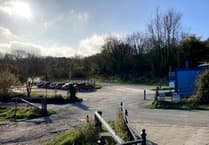Archaeologists are hoping to return to Pen Dinas next summer after a “really exciting” dig came to an end in September.
Dyfed Archaeological Trust held a three-week dig of the ancient hillfort, Pen Dinas, last month, thanks to funding from Cadw.
Archaeologist Luke Jenkins said the team are hoping the excavation will turn into a “larger project” and that they can return for another dig next summer.
“We’re hoping it turns into a larger project, not only in terms of the archaeological trenching, but also in terms of how much outreach we can do,” Luke said.
“We certainly hope we can come back to do more work over the years – once again asking those questions about how the fort evolved.
“I suspect it will next summer, that’s the hope anyway. But again it depends on the funders.”
On this year’s dig, Luke explained: “It was really exciting what we found. What we were looking at this year was the south entrance of the south fort.
“We were also looking at Daryl Ford’s trenches from the 1930s, to understand how he excavated the site.
“What we hoped to do, from an archaeological point of view, was look at the chronology he created for the fort and see whether that was valid.
“The 1930s dig was a good standard for the time, but we have a 100 year archaeological advancement now. Carbon dating didn’t exist back then, and neither did modern concepts about stratigraphy.
“During the dig, we found a spindle whorl, which is used for the spinning of yarn, and two beautifully made beads – an amber bead and a stone bead. The amber bead is very rare and would have been imported from the Baltic probably, which shows how interconnected the society was. They had actually fallen into the small gullys, so you can almost imagine somebody losing it down the back of their sofa.”
“Hillforts aren’t particularly well understood monuments, they were defensive but there’s so much more going on than that. They were places of trade, ceremony, and settlement.”
If the team return for another dig, Luke said they would “move on to a different part of the fort, to understand how the whole structure was used”.
As well as this, Luke said they were “very pleased about the local enthusiasm for the project” , with over 60 volunteers helping out.
“Not everyone knows the largest hillfort in Ceredigion sits immediately above Aberystwyth and Penparcau. It is one of the most spectacular Iron Age hillforts in this part of the world.”




